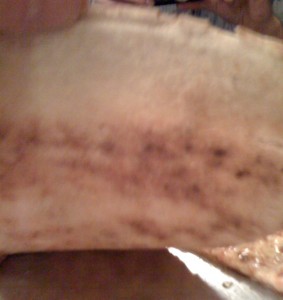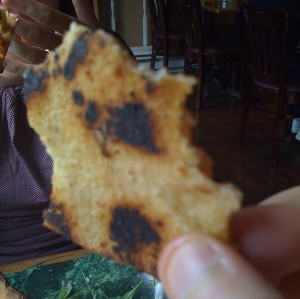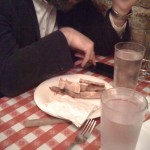
Lombardi char
I can’t top Luke’s tour de force account of last night’s CUNY Pie debut. But I do have some pointed commentary on a subject that is dear to my heart – the cornicione – which is prompted by the trip to Lombardi’s.
I am not a particularly sentimental man, but something about a chewy, crispy, charred crust brings the romance out of me. Indulge me: What could be more beautiful than the relationship between a hungry mouth and a hyperglutenous ring of dough? Like all great romances, this one is not without its tensions. Any decent cornicione puts up too much of a fight to simply be bitten off. You have to clench, you have to tear. The best ovens impart the flavor of their many years into those Maillard marks, bits of black that can taste bitter at first. Children might prefer an undercooked doughiness to a deep char, in the same way that they can’t appreciate the many layers of a great love story. Yet, for the initiated, the tensions of the fight make the end result that much more satisfying.

Anselmo char
It’s tragic, then, when a place like Lombardi’s – with the benefit of a rich history, and, more importantly, of a fantastic oven – undercooks their pizzas. Compare the two pictures at the right: the first is of last night’s Lombardi’s plain pie, while the second is from Anselmo’s in Red Hook. Luke has already quoted me on this, but c’mon: thirty, even fifteen more seconds would have made all the difference. Is it that the kitchen is so crowded that the extra fifteen seconds would put them far behind? (Doesn’t seem to bother Dom DeMarco.) Or is it pandering to tourist taste? Is it that non-New Yorkers can’t handle char, and that Lombardi’s is caving?

Lombardi's leavings
I can’t blame Lombardi’s for wanting to pack the place with tourists. But c’mon.
That said, there’s something unquestionably special about the way that a Lombardi’s pie comes out of the oven: the crust is thinner and crisper than the average NY pie, and the cornicione is far chewier than you’d expect given its Booneish complexion. Which is why the picture at the left makes me so darn sad. If it weren’t for “decorum” and “manners” and “not being a gross slob”, I would totally have eaten my fellow diner’s tragically uneaten crusts.


Let me be the first to proclaim: I ate my crust.
Charitable fellow that I am, I cropped the picture so you couldn’t tell whose uneaten crusts those were. But I’ll be the second to proclaim that I ate mine.
All you had to do was ask.
This reminds me that a few months ago, CUNY Academic Commons member Barbara Walters alerted me to the following New York Times article: Crust Is a Canvas for Pizza’s New Wave. Here’s a short excerpt:
Definitely of relevance to those of us at CUNY Pie; in fact, this is something like a manifesto for our group.